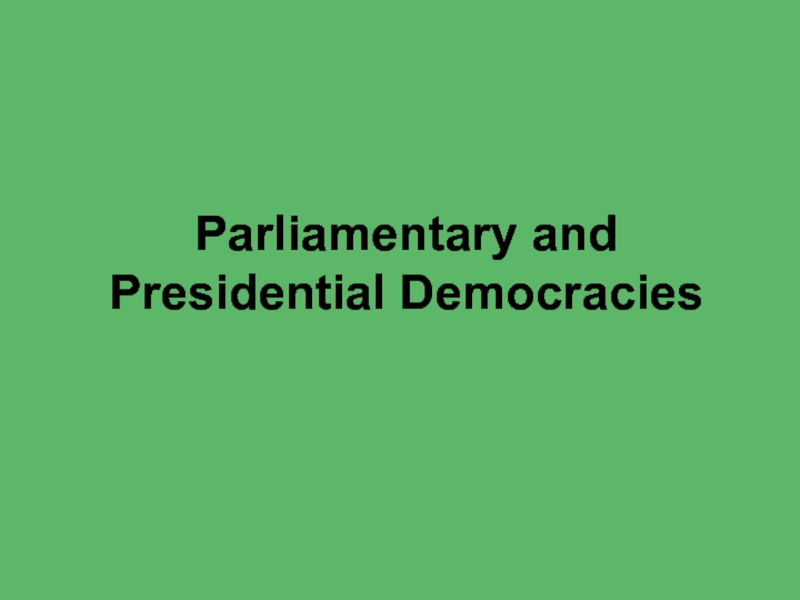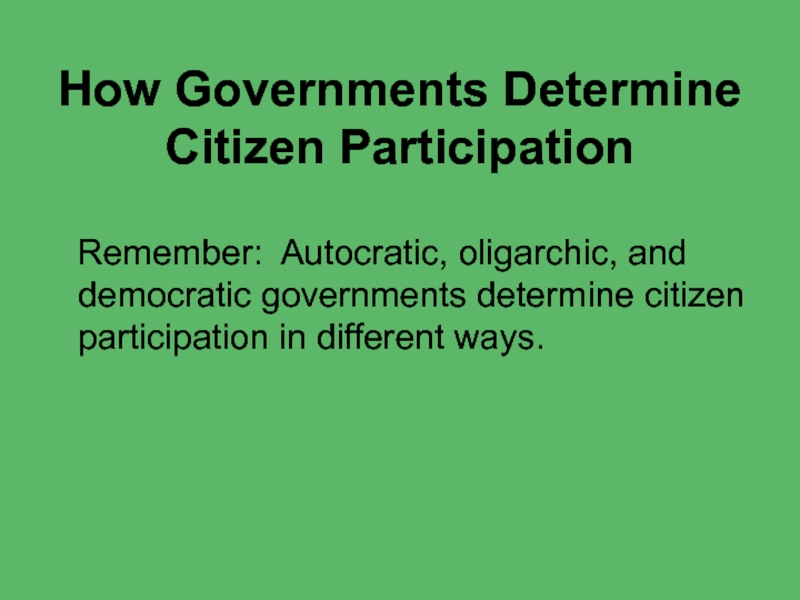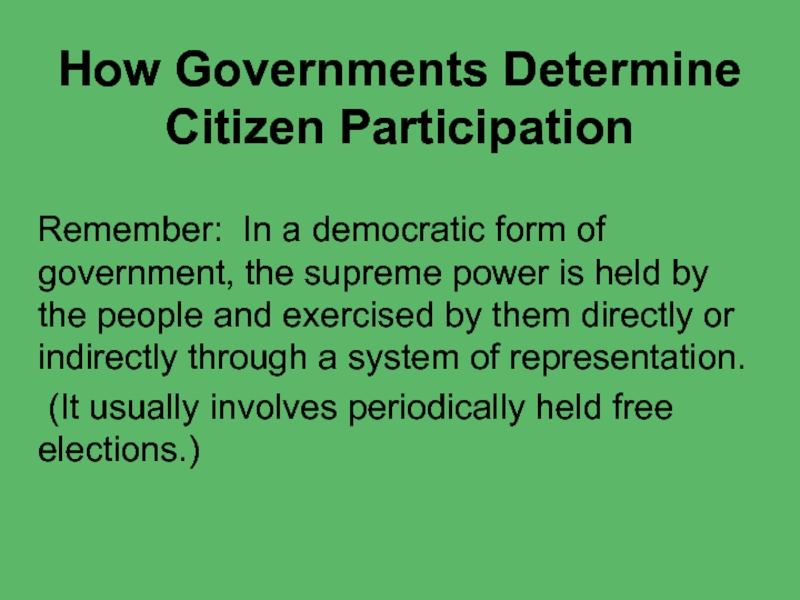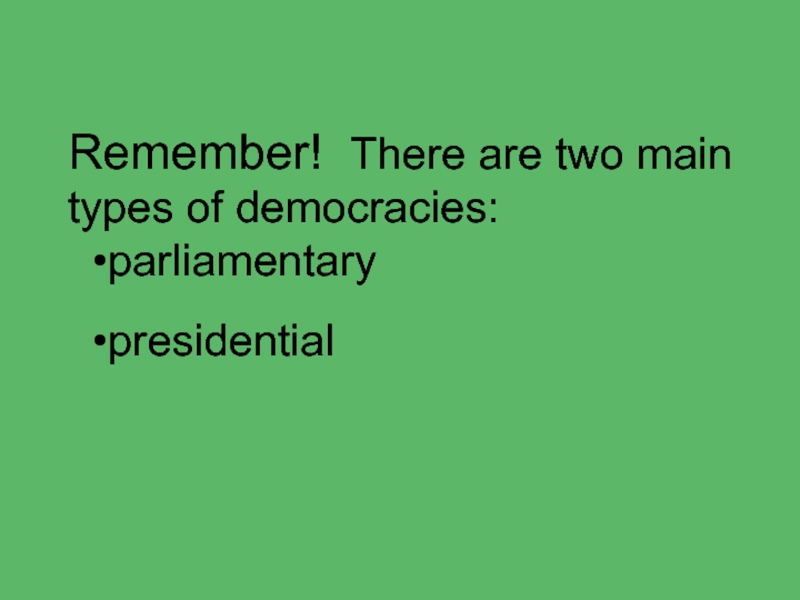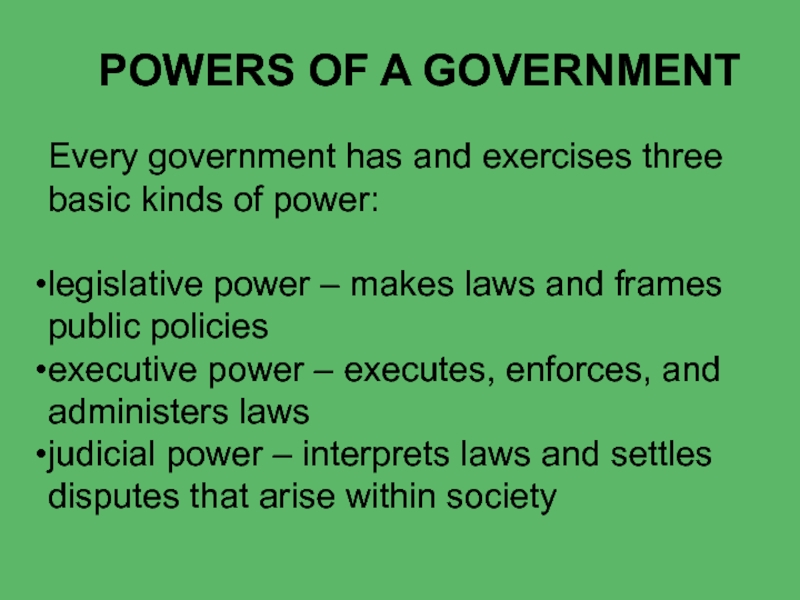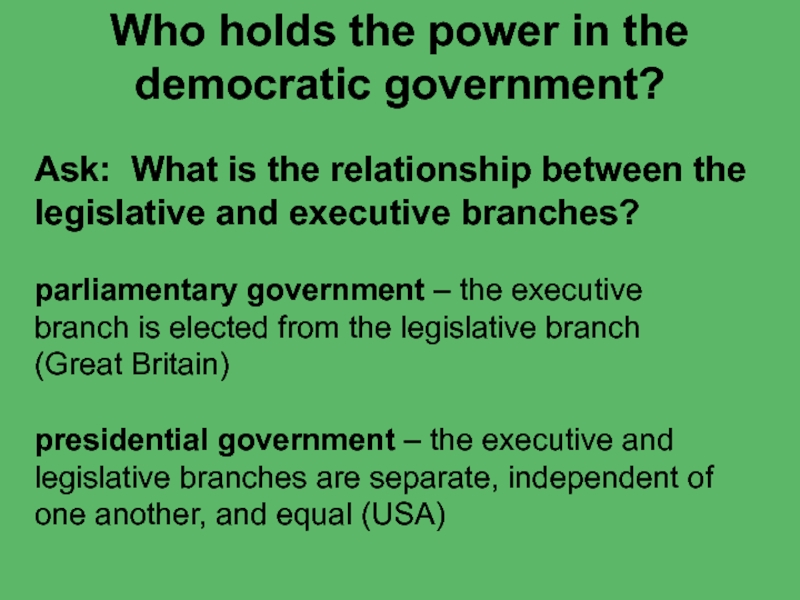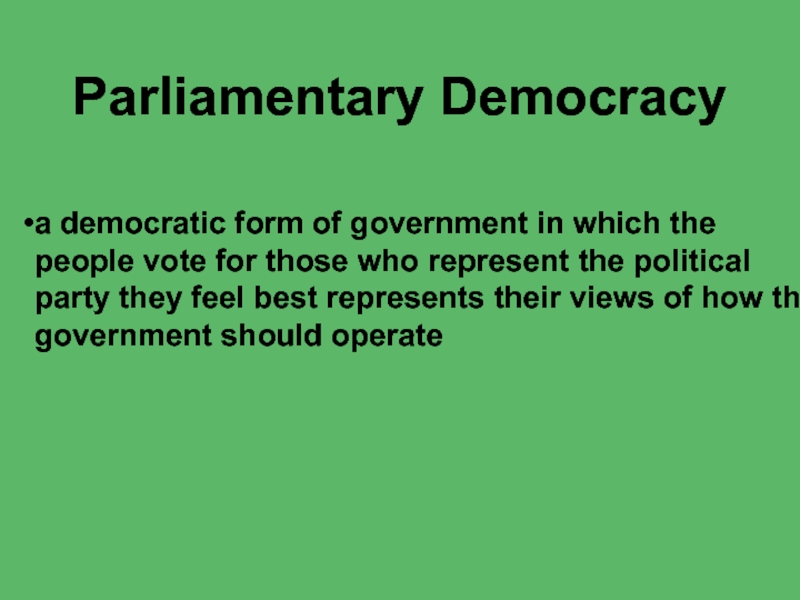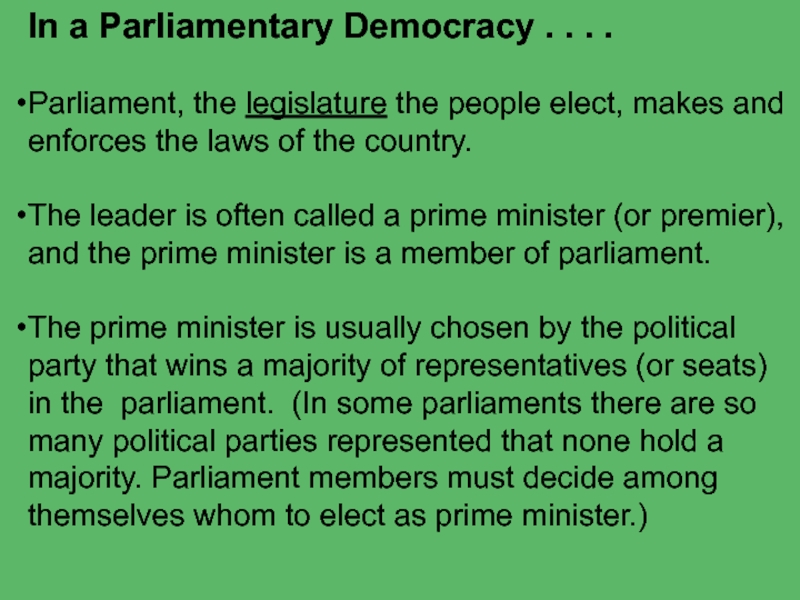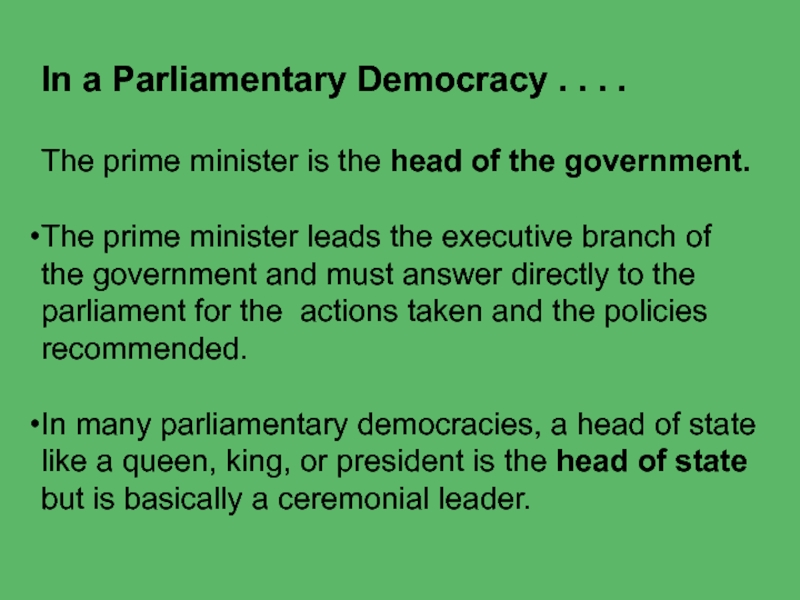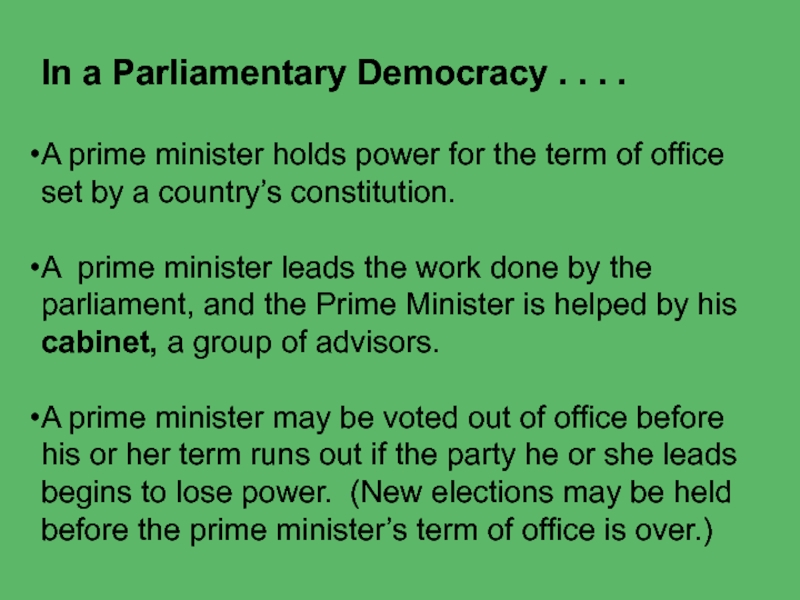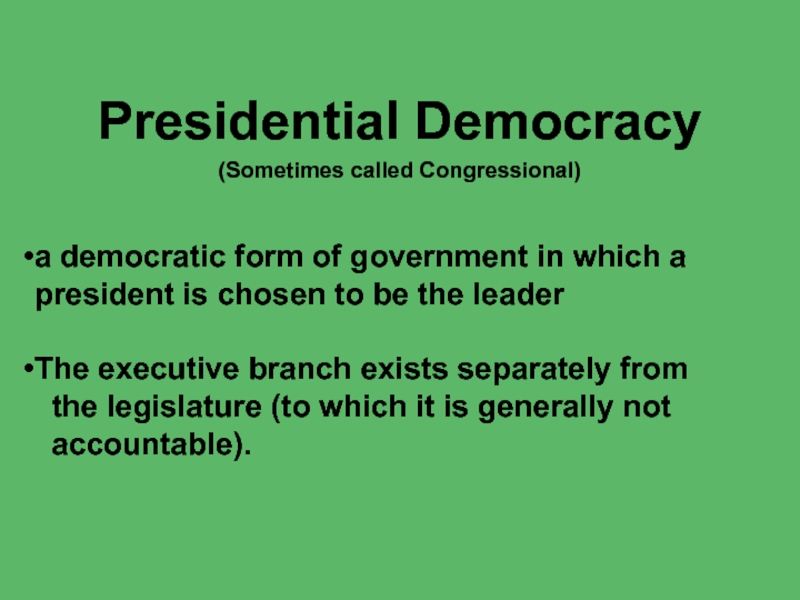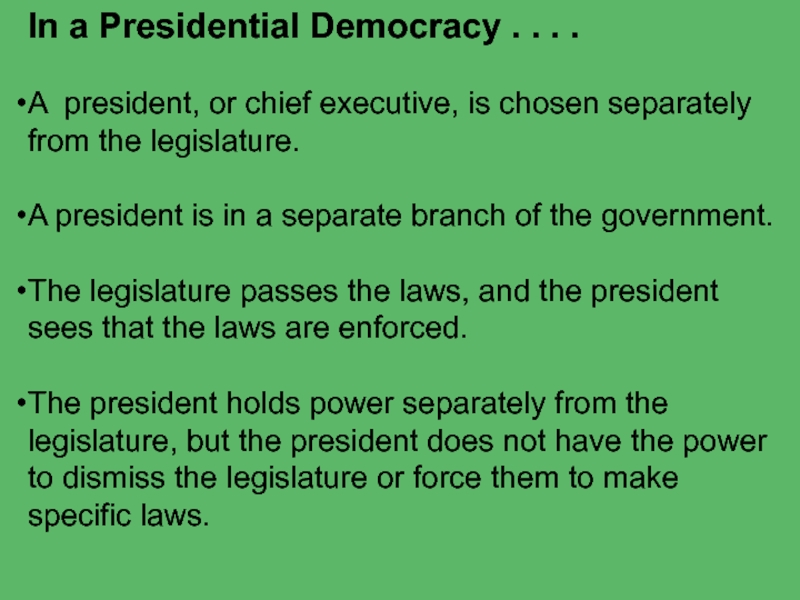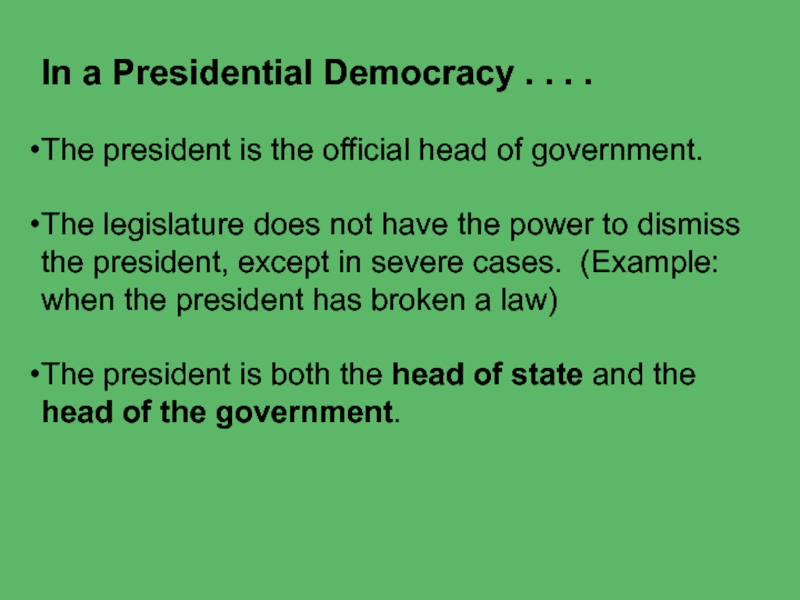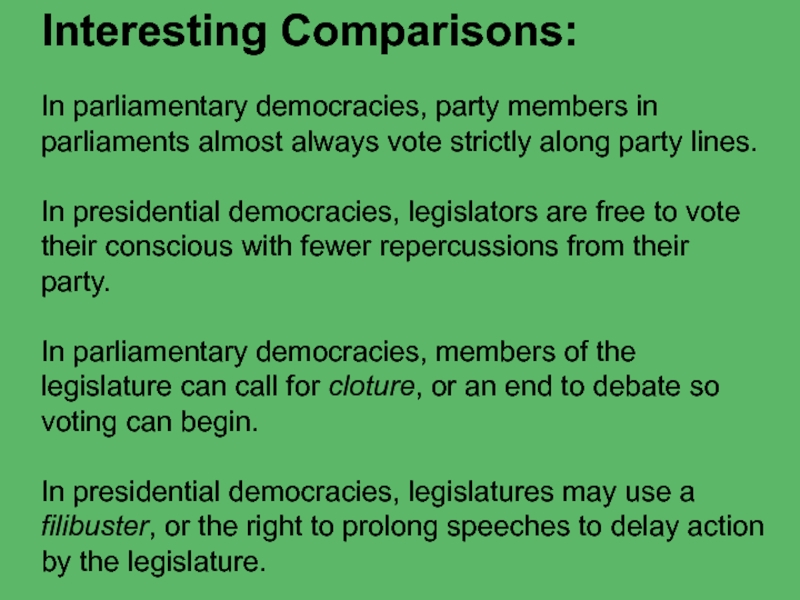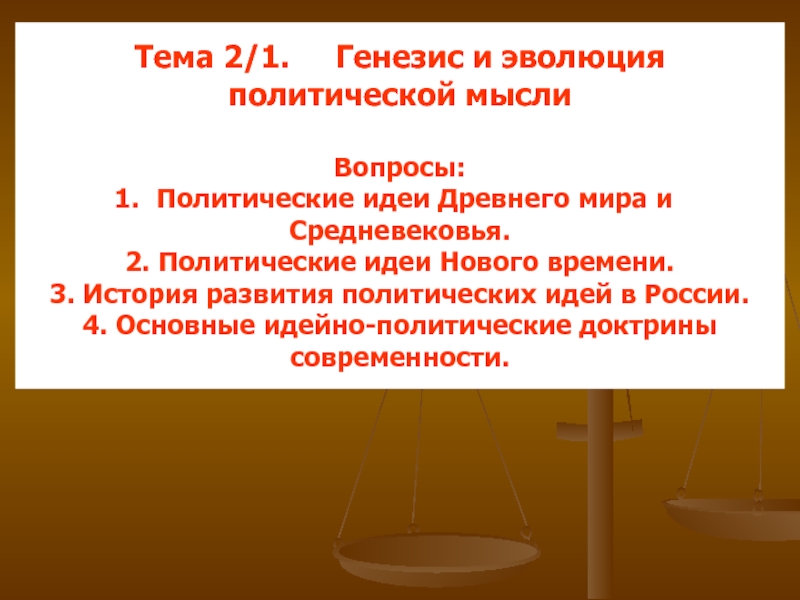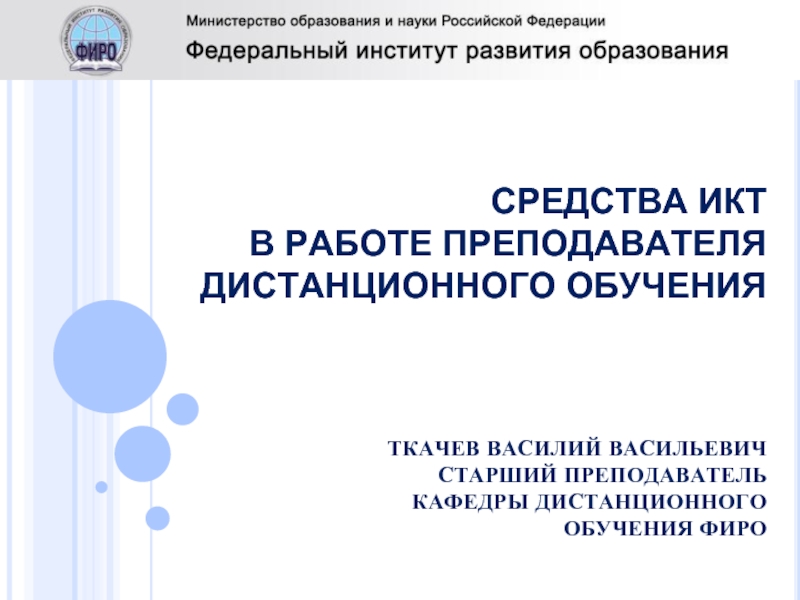- Главная
- Разное
- Дизайн
- Бизнес и предпринимательство
- Аналитика
- Образование
- Развлечения
- Красота и здоровье
- Финансы
- Государство
- Путешествия
- Спорт
- Недвижимость
- Армия
- Графика
- Культурология
- Еда и кулинария
- Лингвистика
- Английский язык
- Астрономия
- Алгебра
- Биология
- География
- Детские презентации
- Информатика
- История
- Литература
- Маркетинг
- Математика
- Медицина
- Менеджмент
- Музыка
- МХК
- Немецкий язык
- ОБЖ
- Обществознание
- Окружающий мир
- Педагогика
- Русский язык
- Технология
- Физика
- Философия
- Химия
- Шаблоны, картинки для презентаций
- Экология
- Экономика
- Юриспруденция
Parliamentary and Presidential Democracies презентация
Содержание
- 1. Parliamentary and Presidential Democracies
- 2. How Governments Determine Citizen Participation
- 3. How Governments Determine Citizen Participation
- 4. Remember! There are two main types of democracies: parliamentary presidential
- 5. POWERS OF A GOVERNMENT Every government
- 6. Who holds the power in the democratic
- 7. Parliamentary Democracy a democratic form of government
- 8. In a Parliamentary Democracy . . .
- 9. In a Parliamentary Democracy . . .
- 10. In a Parliamentary Democracy . . .
- 11. Presidential Democracy (Sometimes called Congressional)
- 12. In a Presidential Democracy . . .
- 13. In a Presidential Democracy . . .
- 14. Interesting Comparisons: In parliamentary democracies, party
Слайд 2How Governments Determine Citizen Participation
Remember: Autocratic, oligarchic, and democratic
governments determine citizen participation in different ways.
Слайд 3How Governments Determine Citizen Participation
Remember: In a democratic form
of government, the supreme power is held by the people and exercised by them directly or indirectly through a system of representation.
(It usually involves periodically held free elections.)
(It usually involves periodically held free elections.)
Слайд 5POWERS OF A GOVERNMENT
Every government has and exercises three basic kinds
of power:
legislative power – makes laws and frames
public policies
executive power – executes, enforces, and
administers laws
judicial power – interprets laws and settles
disputes that arise within society
legislative power – makes laws and frames
public policies
executive power – executes, enforces, and
administers laws
judicial power – interprets laws and settles
disputes that arise within society
Слайд 6Who holds the power in the democratic government?
Ask: What is the
relationship between the legislative and executive branches?
parliamentary government – the executive
branch is elected from the legislative branch
(Great Britain)
presidential government – the executive and
legislative branches are separate, independent of one another, and equal (USA)
parliamentary government – the executive
branch is elected from the legislative branch
(Great Britain)
presidential government – the executive and
legislative branches are separate, independent of one another, and equal (USA)
Слайд 7Parliamentary Democracy
a democratic form of government in which the people vote
for those who represent the political party they feel best represents their views of how the government should operate
Слайд 8In a Parliamentary Democracy . . . .
Parliament, the legislature
the people elect, makes and enforces the laws of the country.
The leader is often called a prime minister (or premier), and the prime minister is a member of parliament.
The prime minister is usually chosen by the political party that wins a majority of representatives (or seats) in the parliament. (In some parliaments there are so many political parties represented that none hold a majority. Parliament members must decide among themselves whom to elect as prime minister.)
The leader is often called a prime minister (or premier), and the prime minister is a member of parliament.
The prime minister is usually chosen by the political party that wins a majority of representatives (or seats) in the parliament. (In some parliaments there are so many political parties represented that none hold a majority. Parliament members must decide among themselves whom to elect as prime minister.)
Слайд 9In a Parliamentary Democracy . . . .
The prime minister
is the head of the government.
The prime minister leads the executive branch of the government and must answer directly to the parliament for the actions taken and the policies recommended.
In many parliamentary democracies, a head of state like a queen, king, or president is the head of state but is basically a ceremonial leader.
The prime minister leads the executive branch of the government and must answer directly to the parliament for the actions taken and the policies recommended.
In many parliamentary democracies, a head of state like a queen, king, or president is the head of state but is basically a ceremonial leader.
Слайд 10In a Parliamentary Democracy . . . .
A prime minister
holds power for the term of office set by a country’s constitution.
A prime minister leads the work done by the parliament, and the Prime Minister is helped by his cabinet, a group of advisors.
A prime minister may be voted out of office before his or her term runs out if the party he or she leads begins to lose power. (New elections may be held before the prime minister’s term of office is over.)
A prime minister leads the work done by the parliament, and the Prime Minister is helped by his cabinet, a group of advisors.
A prime minister may be voted out of office before his or her term runs out if the party he or she leads begins to lose power. (New elections may be held before the prime minister’s term of office is over.)
Слайд 11Presidential Democracy
(Sometimes called Congressional)
a democratic form of government in which a
president is chosen to be the leader
The executive branch exists separately from
the legislature (to which it is generally not
accountable).
The executive branch exists separately from
the legislature (to which it is generally not
accountable).
Слайд 12In a Presidential Democracy . . . .
A president, or
chief executive, is chosen separately from the legislature.
A president is in a separate branch of the government.
The legislature passes the laws, and the president sees that the laws are enforced.
The president holds power separately from the legislature, but the president does not have the power to dismiss the legislature or force them to make specific laws.
A president is in a separate branch of the government.
The legislature passes the laws, and the president sees that the laws are enforced.
The president holds power separately from the legislature, but the president does not have the power to dismiss the legislature or force them to make specific laws.
Слайд 13In a Presidential Democracy . . . .
The president is
the official head of government.
The legislature does not have the power to dismiss the president, except in severe cases. (Example: when the president has broken a law)
The president is both the head of state and the head of the government.
The legislature does not have the power to dismiss the president, except in severe cases. (Example: when the president has broken a law)
The president is both the head of state and the head of the government.
Слайд 14Interesting Comparisons:
In parliamentary democracies, party members in parliaments almost always vote
strictly along party lines.
In presidential democracies, legislators are free to vote their conscious with fewer repercussions from their party.
In parliamentary democracies, members of the legislature can call for cloture, or an end to debate so voting can begin.
In presidential democracies, legislatures may use a filibuster, or the right to prolong speeches to delay action by the legislature.
In presidential democracies, legislators are free to vote their conscious with fewer repercussions from their party.
In parliamentary democracies, members of the legislature can call for cloture, or an end to debate so voting can begin.
In presidential democracies, legislatures may use a filibuster, or the right to prolong speeches to delay action by the legislature.
